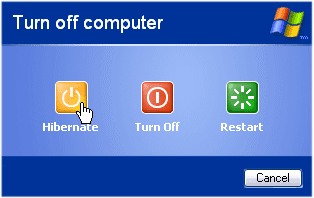Typically, you put your computer in hibernation when you will be away from the computer for an extended time or overnight. When you restart the computer, your desktop is restored exactly as you left it.

To put your system in hibernate, press Turn Off Computer on the Start menu, and on the next window, put your cursor over the Stand By button. Now press the Shift key on your keyboard. Stand By will change to Hibernate.
To use Windows Power Options, you must have a computer that is set up by the manufacturer to support these features. For more information, see the documentation that came with your computer.
What you need to know is that if hibernate is enabled on your computer, a hidden file hiberfill.sys is created in the root of your system drive (usually C:\), which is around the same size as your system's memory (RAM). You can't move this file to another drive, it has to be in the root of your system drive. If you don't use hibernate, you can remove this file by going to the Power Options in Control Panel, and on the Hibernate tab un-check Enable hibernation


0 comments:
Post a Comment